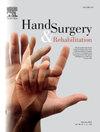Fractal geometry in wrist biomechanics: A preliminary study with implications for arthroplasty and surgery
IF 1
4区 医学
Q4 ORTHOPEDICS
引用次数: 0
Abstract
Background
Traditional biomechanical theories of wrist motion—such as row, column, and link joint models—offer limited explanations for the complex, multidirectional kinematics observed clinically. Emerging perspectives suggest fractal geometry, represented by the Golden Ratio (φ = 1.618), might underlie wrist biomechanics, providing a more comprehensive and clinically relevant framework.
Objectives
This preliminary radiographic study aims to investigate whether wrist anthropometric ratios align significantly with fractal geometry principles, specifically evaluating their consistency with the Golden Ratio. Additionally, the study explores potential implications for wrist arthroplasty design and surgical practice.
Methods
A cross-sectional radiographic analysis was conducted on 210 healthy adult wrist radiographs. Anthropometric measurements included ratios between ulnar styloid, radial styloid, and the capitate bone, defined as A/B and (A + B)/C, and were statistically compared to the Golden Ratio. Statistical analyses incorporated tolerance intervals calculated under both normal and log-normal distribution assumptions, with a significance level set at P < 0.05.
Results
Mean anthropometric ratios closely matched the Golden Ratio, with an A/B mean of 1.615 (95% CI: 1.503–1.735) and an (A + B)/C mean of 1.620 (95% CI: 1.503–1.735). Tolerance intervals indicated that 95% of the study population fell within the fractal range (1.503–1.735), irrespective of age, gender, or laterality. High interobserver reliability (ICC = 0.91) further validated the consistency of these measurements.
Conclusion
The findings support the hypothesis that wrist biomechanics may be fundamentally organized by fractal geometry. These preliminary results challenge existing biomechanical paradigms and highlight potential applications in designing more biomechanically accurate wrist prostheses and enhancing surgical precision. Future research should assess clinical outcomes related to fractal-based prosthetic designs and explore fractal deviations as early indicators of wrist pathology.
腕部生物力学中的分形几何:关节置换术和外科手术的初步研究。
背景:传统的腕部运动生物力学理论,如行、柱和链接关节模型,对临床观察到的复杂、多向的运动学解释有限。新兴观点认为,以黄金比例(φ = 1.618)为代表的分形几何可能是腕部生物力学的基础,提供了一个更全面和临床相关的框架。目的:这项初步的放射学研究旨在探讨腕部人体测量比例是否与分形几何原理显著一致,特别是评估其与黄金比例的一致性。此外,该研究还探讨了腕关节置换术设计和手术实践的潜在意义。方法:对210张健康成人腕关节x线片进行横断面放射学分析。人体测量包括尺骨茎突、桡骨茎突和头状骨的比值,定义为A/B和(A + B)/C,并与黄金比例进行统计比较。统计分析包括在正态分布和对数正态分布假设下计算的公差区间,显著性水平设为P。结果:平均人体测量比与黄金比例密切匹配,a /B平均值为1.615 (95% CI: 1.503-1.735), (a + B)/C平均值为1.620 (95% CI: 1.503-1.735)。容忍区间表明95%的研究人群落在分形范围内(1.503-1.735),与年龄、性别或偏侧性无关。高观察者间信度(ICC = 0.91)进一步验证了这些测量的一致性。结论:研究结果支持了腕部生物力学可能从根本上由分形几何组织的假设。这些初步结果挑战了现有的生物力学范式,并强调了在设计更精确的生物力学腕假体和提高手术精度方面的潜在应用。未来的研究应该评估与基于分形的假肢设计相关的临床结果,并探索分形偏差作为腕部病理的早期指标。
本文章由计算机程序翻译,如有差异,请以英文原文为准。
求助全文
约1分钟内获得全文
求助全文
来源期刊

Hand Surgery & Rehabilitation
Medicine-Surgery
CiteScore
1.70
自引率
27.30%
发文量
0
审稿时长
49 days
期刊介绍:
As the official publication of the French, Belgian and Swiss Societies for Surgery of the Hand, as well as of the French Society of Rehabilitation of the Hand & Upper Limb, ''Hand Surgery and Rehabilitation'' - formerly named "Chirurgie de la Main" - publishes original articles, literature reviews, technical notes, and clinical cases. It is indexed in the main international databases (including Medline). Initially a platform for French-speaking hand surgeons, the journal will now publish its articles in English to disseminate its author''s scientific findings more widely. The journal also includes a biannual supplement in French, the monograph of the French Society for Surgery of the Hand, where comprehensive reviews in the fields of hand, peripheral nerve and upper limb surgery are presented.
Organe officiel de la Société française de chirurgie de la main, de la Société française de Rééducation de la main (SFRM-GEMMSOR), de la Société suisse de chirurgie de la main et du Belgian Hand Group, indexée dans les grandes bases de données internationales (Medline, Embase, Pascal, Scopus), Hand Surgery and Rehabilitation - anciennement titrée Chirurgie de la main - publie des articles originaux, des revues de la littérature, des notes techniques, des cas clinique. Initialement plateforme d''expression francophone de la spécialité, la revue s''oriente désormais vers l''anglais pour devenir une référence scientifique et de formation de la spécialité en France et en Europe. Avec 6 publications en anglais par an, la revue comprend également un supplément biannuel, la monographie du GEM, où sont présentées en français, des mises au point complètes dans les domaines de la chirurgie de la main, des nerfs périphériques et du membre supérieur.
 求助内容:
求助内容: 应助结果提醒方式:
应助结果提醒方式:


